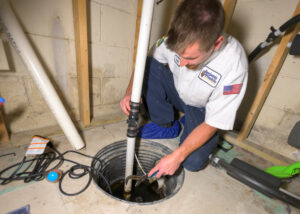What is a Sump Pump?
In simple terms, a sump pump is a device that moves water from a low-lying area, typically a pit called a sump, to a place where it can drain away safely.
You’ll often find sump pumps in basements or crawl spaces, where water tends to accumulate. Essentially, they prevent flooding by removing excess water from these vulnerable areas.
Types of Sump Pumps
There are two main types of sump pumps: submersible and pedestal. Submersible pumps are fully submerged underwater, while pedestal pumps remain above ground, with only their inlet filter submerged.
Submersible pumps are generally quieter than pedestal pumps, but they may not last as long due to being constantly underwater. The choice between them depends on factors like the severity of the water problem and maintenance preferences.
How Sump Pumps Work
Sump pumps are strategically placed in the lowest point of a home, where water is most likely to collect. They are equipped with a float switch, which is activated when water levels rise beyond a certain point.
Once activated, the pump springs into action, directing water through a hose to a safe location away from the home.
During bad weather, when sump pumps are most needed, they need to have a battery backup. This ensures they can continue running even during power outages, providing uninterrupted protection against flooding.

How Often Should A Sump Pump Run?
Understanding when to run your sump pump is crucial for protecting your home from flooding. Typically, on dry days, your sump pump should remain idle, ready to act if excess water appears.
It’s like a silent guardian, always on standby to spring into action when needed.The secret behind its activation lies in the float switch, a smart mechanism submerged in the pit.
As water levels rise due to heavy rain or groundwater, the float switch detects the increase. When the water reaches a certain level, it triggers the switch, signaling the pump to turn on.
Once activated, the pump gets to work, draining water from the pit and directing it away from your home. Some pumps divert water to a drain, while others lead it to a detention pond or dry well.
The frequency of sump pump operation varies depending on factors like rainfall patterns and property location. In rainy areas, the pump may run several times a day, while in drier regions, it’s needed less frequently.
Continuous running of the sump pump signals a potential problem. It should only operate when necessary, indicating that water levels have risen enough to activate the float switch.
If it runs continuously, it’s essential to investigate and address any issues promptly to prevent flooding and damage to your home.
Why Does My Sump Pump Run Continuously?
If your sump pump keeps running all the time, it might mean something’s wrong. But not always! Sometimes, heavy rain makes it work extra hard to keep your home dry. However, if it runs non-stop even on dry days, there could be issues to address.
Let’s check out some common reasons why your sump pump might be acting up:
Broken Water Main Underground
If there’s a break in the underground water pipe, it can cause problems. To check if it’s the reason your sump pump runs a lot, try turning off the main water supply.
Negative Ground Grade
When the ground around your home slopes toward it, it’s called a negative grade. This can make rainwater flow toward your home, increasing the risk of flooding. You can fix it by building up the ground so water flows away from your home.
Groundwater Level
Sometimes, high groundwater levels or issues with drain tiles can lead to too much water in the basement. Sealing the basement or using waterproof paint might help fix this problem.
Inadequate Power
If your sump pump is too small for your home’s needs, it might struggle to keep up. Investing in a more powerful pump can help it handle the demand and prevent constant running.
Broken Float Switch
A float switch can get stuck or damaged, causing it to activate too often. Fixing or replacing the float switch is essential to prevent energy waste.
Clogged or Frozen Discharge Line
If the discharge line is clogged or frozen, water can’t leave the house. This makes the sump pump keep running. Clearing the clog or thawing the line can solve the problem.
Broken Check Valve
The check valve stops pumped-out water from flowing back in. If it’s broken, water will return, making the pump run continuously. Replacing the broken valve can fix this issue.
Make Your Sump Pump All Seasons Ready
Ensure your sump pump is ready for any situation with All Seasons Sump Pump Services. We offer backup battery installation, repairs, maintenance, and installation to keep your home protected from flooding.
Our team of skilled and friendly plumbers is dedicated to providing top-notch service and industry-leading guarantees. Don’t risk expensive damage—trust Benjamin Franklin Plumbing to keep your sump pump All Seasons ready.
